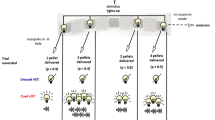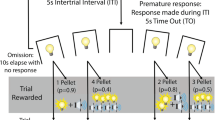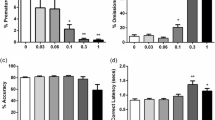Abstract
Rationale
The inability to make profitable long-term decisions has been implicated in several psychiatric disorders. There is emerging evidence to support a role for dopamine (DA) in decision making, but our understanding of the role of noradrenaline (NA) and serotonin (5-HT) in decision making, and of possible interactions between the three monoamines, is limited. Moreover, impulsivity has been associated with aberrant decision making, but the underlying mechanisms are incompletely understood.
Objective
The purpose of this study is to improve our understanding of the neuropharmacological mechanisms of decision making and impulse control.
Methods
We investigated the effects of amphetamine (0.25–1.0 mg/kg) and selective reuptake inhibitors of DA (GBR12909; 2.5–10 mg/kg), NA (atomoxetine; 0.3–3.0 mg/kg), and 5-HT (citalopram; 0.3–3.0 mg/kg) in a rat gambling task (rGT). Since the rGT allows for detection of impulsive action, i.e., premature responding, we also assessed the relationship between decision making and impulsivity.
Results
In the rGT, rats developed an optimal choice strategy from the first session onwards. Elevation of endogenous DA or NA levels increased and decreased impulsivity, respectively, but did not alter decision making. However, simultaneous blockade of DA and NA disrupted decision making, reflected by a relative decrease in choice for the advantageous choice options. Increasing 5-HT neurotransmission did not affect decision making or impulsivity.
Conclusions
These data suggest important but complementary or redundant roles of DA and NA neurotransmission in decision-making processes based on reward probability and punishment. Moreover, impulse control and decision making in the rGT rely on dissociable mechanisms.





Similar content being viewed by others
References
Arnsten AFT (1997) Catecholamine regulation of the prefrontal cortex. J Psychopharmacol 11:151–162
Arnsten AFT (2000) Through the looking glass: differential noradrenergic modulation of prefrontal cortical function. Neural Plast 7:133–146
Aston-Jones G, Cohen JD (2005) An integrative theory of locus coeruleus–norepinephrine function: adaptive gain and optimal performance. Annu Rev Neurosci 28:403–450
Baarendse PJJ, Vanderschuren LJMJ (2012) Dissociable effects of monoamine reuptake inhibitors on distinct forms of impulsive behavior in rats. Psychopharmacology 219:313–326
Bark R, Dieckmann S, Bogerts B, Northoff G (2005) Deficit in decision making in catatonic schizophrenia: an exploratory study. Psychiatry Res 134:131–141
Bechara A, Damasio H (2002) Decision-making and addiction (part I): impaired activation of somatic states in substance dependent individuals when pondering decisions with negative future consequences. Neuropsychologia 40:1675–1689
Bechara A, Damasio AR, Damasio H, Anderson SW (1994) Insensitivity to future consequences following damage to human prefrontal cortex. Cognition 50:7–15
Bechara A, Dolan S, Denburg N, Hindes A, Anderson SW, Nathan PE (2001) Decision-making deficits, linked to a dysfunctional ventromedial prefrontal cortex, revealed in alcohol and stimulant abusers. Neuropsychologia 39:376–389
Berridge KC (2007) The debate over dopamine’s role in reward: the case for incentive salience. Psychopharmacology 191:391–431
Blondeau C, Dellu-Hagedorn F (2007) Dimensional analysis of ADHD subtypes in rats. Biol Psychiatry 61:1340–1350
Boureau Y-L, Dayan P (2010) Opponency revisited: competition and cooperation between dopamine and serotonin. Neuropsychopharmacology 36:74–97
Bouret S, Sara SJ (2005) Network reset: a simplified overarching theory of locus coeruleus noradrenaline function. Trends Neurosci 28:574–582
Brand M, Labudda K, Kalbe E, Hilker R, Emmans D, Fuchs G, Kessler J, Markowitsch HJ (2004) Decision-making impairments in patients with Parkinson’s disease. Behav Neurol 15:77–85
Brand M, Kalbe E, Labudda K, Fujiwara E, Kessler J, Markowitsch HJ (2005) Decision-making impairments in patients with pathological gambling. Psychiatry Res 133:91–99
Brand M, Recknor EC, Grabenhorst F, Bechara A (2007) Decisions under ambiguity and decisions under risk: correlations with executive functions and comparisons of two different gambling tasks with implicit and explicit rules. J Clin Exp Neuropsychol 29:86–99
Cardinal RN, Robbins TW, Everitt BJ (2000) The effects of d-amphetamine, chlordiazepoxide, alpha-flupenthixol and behavioural manipulations on choice of signalled and unsignalled delayed reinforcement in rats. Psychopharmacology 152:362–375
Carli M, Robbins TW, Evenden JL, Everitt BJ (1983) Effects of lesions to ascending noradrenergic neurones on performance of a 5-choice serial reaction task in rats; implications for theories of dorsal noradrenergic bundle function based on selective attention and arousal. Behav Brain Res 9:361–380
Cavedini P, Riboldi G, Keller R, D’annucci A, Bellodi L (2002) Frontal lobe dysfunction in pathological gambling patients. Biol Psychiatry 51:334–341
Cole BJ, Robbins TW (1987) Amphetamine impairs the discriminative performance of rats with dorsal noradrenergic bundle lesions on a 5-choice serial reaction time task: new evidence for central dopaminergic–noradrenergic interactions. Psychopharmacology 91:458–466
Cole BJ, Robbins TW (1992) Forebrain norepinephrine: role in controlled information processing in the rat. Neuropsychopharmacology 7:129–142
Cools R, Roberts AC, Robbins TW (2008) Serotoninergic regulation of emotional and behavioural control processes. Trends Cogn Sci 12:31–40
Cools R, Nakamura K, Daw ND (2011) Serotonin and dopamine: unifying affective, activational, and decision functions. Neuropsychopharmacology 36:98–113
Dalley JW, McGaughy J, O’Connell MT, Cardinal RN, Levita L, Robbins TW (2001) Distinct changes in cortical acetylcholine and noradrenaline efflux during contingent and noncontingent performance of a visual attentional task. J Neurosci 21:4908–4914
Dalley JW, Cardinal RN, Robbins TW (2004) Prefrontal executive and cognitive functions in rodents: neural and neurochemical substrates. Neurosci Biobehav Rev 28:771–784
Dalley JW, Everitt BJ, Robbins TW (2011) Impulsivity, compulsivity, and top-down cognitive control. Neuron 69:680–694
Dayan P, Huys QJ (2008) Serotonin, inhibition, and negative mood. PLoS Comput Biol 4:e4
Denk F, Walton ME, Jennings KA, Sharp T, Rushworth MFS, Bannerman DM (2005) Differential involvement of serotonin and dopamine systems in cost–benefit decisions about delay or effort. Psychopharmacology 179:587–596
Eagle DM, Baunez C (2010) Is there an inhibitory-response-control system in the rat? Evidence from anatomical and pharmacological studies of behavioral inhibition. Neurosci Biobehav Rev 34:50–72
Ernst M, Paulus MP (2005) Neurobiology of decision making: a selective review from a neurocognitive and clinical perspective. Biol Psychiatry 58:597–604
Ernst M, Grant SJ, London ED, Contoreggi CS, Kimes AS, Spurgeon L (2003) Decision making in adolescents with behavior disorders and adults with substance abuse. Am J Psychiatry 160:33–40
Evenden JL (1999) Varieties of impulsivity. Psychopharmacology 146:348–361
Fernando AB, Economidou D, Theobald DE, Zou MF, Newman AH, Spoelder M, Caprioli D, Moreno M, Hipόlito L, Aspinall AT, Robbins TW, Dalley JW (2012) Modulation of high impulsivity and attentional performance in rats by selective direct and indirect dopaminergic and noradrenergic receptor agonists. Psychopharmacology 219:341–352
Floresco SB, Jentsch JD (2011) Pharmacological enhancement of memory and executive functioning in laboratory animals. Neuropsychopharmacology 36:227–250
Floresco SB, Magyar O (2006) Mesocortical dopamine modulation of executive functions: beyond working memory. Psychopharmacology 188:567–585
Floresco SB, Tse MT, Ghods-Sharifi S (2008a) Dopaminergic and glutamatergic regulation of effort- and delay-based decision making. Neuropsychopharmacology 33:1966–1979
Floresco SB, St. Onge JR, Ghods-Sharifi S, Winstanley CA (2008b) Cortico-limbic-striatal circuits subserving different forms of cost–benefit decision making. Cogn Affect Behav Neurosci 8:375–389
Franken IH, Muris P (2005) Individual differences in decision making. Personal Individ Differ 39:991–998
Franken IH, van Strien JW, Nijs I, Muris P (2008) Impulsivity is associated with behavioral decision-making deficits. Psychiatry Res 158:155–163
Gallagher DA, O’Sullivan SS, Evans AH, Lees AJ, Schrag A (2007) Pathological gambling in Parkinson’s disease: risk factors and differences from dopamine dysregulation. An analysis of published case series. Mov Disord 22:1757–1763
Garon N, Moore C, Waschbusch DA (2006) Decision making in children with ADHD only, ADHD- anxious/depressed, and control children using a child version of the Iowa gambling task. J Atten Disord 9:607–619
Grant JE, Potenza MN (2007) Treatments for pathological gambling and other impulse control disorders. In: Nathan P, Gorman J (eds) A guide to treatments that work. Oxford University Press, Oxford, pp 561–579
Hanson KL, Luciana M, Sullwold K (2008) Reward-related decision-making deficits and elevated impulsivity among MDMA and other drug users. Drug Alcohol Depend 96:99–110
Hollander E, Rosen J (2000) Impulsivity. J Psychopharmacol 14:S39–S44
Johnson SA, Yechiam E, Murphy RR, Queller S, Stout JC (2006) Motivational processes and autonomic responsivity in Asperger’s disorder: evidence from the Iowa Gambling Task. J Int Neuropsychol Soc 12:668–676
Jollant F, Bellivier F, Leboyer M, Astruc B, Torres S, Verdier R, Castelnau D, Malafosse A, Courtet P (2005) Impaired decision making in suicide attempters. Am J Psychiatry 162:304–310
Kranz GS, Kasper S, Lanzenberger R (2010) Reward and the serotonergic system. Neuroscience 166:1023–1035
Kreek MJ, Nielsen DA, Butelman ER, LaForge KS (2005) Genetic influences on impulsivity, risk taking, stress responsivity and vulnerability to drug abuse and addiction. Nat Neurosci 8:1450–1457
Lawrence NS, Wooderson S, Mataix-Cols D, David R, Speckens A, Phillips ML (2006) Decision making and set shifting impairments are associated with distinct symptom dimensions in obsessive–compulsive disorder. Neuropsychology 20:409–419
Luman M, Oosterlaan J, Knol DL, Sergeant JA (2008) Decision-making in ADHD: sensitive to frequency but blind to the magnitude of penalty? J Child Psychol Psychiatry 49:712–722
Malloy-Diniz L, Fuentes D, Leite WB, Correa H, Bechara A (2007) Impulsive behavior in adults with attention deficit/hyperactivity disorder: characterization of attentional, motor and cognitive impulsiveness. J Int Neuropsychol Soc 13:693–698
Mavaddat N, Kirkpatrick PJ, Rogers RD, Sahakian BJ (2000) Deficits in decision-making in patients with aneurysms of the anterior communicating artery. Brain 123:2109–2117
McDonald J (2009) Handbook of biological statistics, 2nd edn. Sparky House Publishing, Baltimore
Mitchell MR, Vokes CM, Blankenship AL, Simon NW, Setlow B (2011) Effects of acute administration of nicotine, amphetamine, diazepam, morphine, and ethanol on risky decision-making in rats. Psychopharmacology 218:703–712
Morgan MJ, Impallomeni LC, Pirona A, Rogers RD (2006) Elevated impulsivity and impaired decision-making in abstinent ecstasy (MDMA) users compared to polydrug and drug-naïve controls. Neuropsychopharmacology 31:1562–1573
Navarra R, Graf R, Huang Y, Logue S, Comery T, Hughes Z, Day M (2008) Effects of atomoxetine and methylphenidate on attention and impulsivity in the 5-choice serial reaction time test. Prog Neuropsychopharmacol Biol Psychiatry 32:34–41
O’Carroll RE, Papps BP (2003) Decision making in humans: the effect of manipulating the central noradrenergic system. J Neurol Neurosurg Psychiatry 74:376–378
O’Donnell JM, Marek GJ, Seiden LS (2005) Antidepressant effects assessed using behavior maintained under a differential-reinforcement-of-low-rate (DRL) operant schedule. Neurosci Biobehav Rev 29:785–798
Ouyang M, Young MB, Lestini MM, Schutsky K, Thomas SA (2012) Redundant catecholamine signaling consolidates fear memory via phospholipase C. J Neurosci 32:1932–1941
Paine TA, Tomasiewicz HC, Zhang K, Carlezon WA (2007) Sensitivity of the five-choice serial reaction time task to the effects of various psychotropic drugs in Sprague–Dawley rats. Biol Psychiatry 62:687–693
Paterson NE, Ricciardi J, Wetzler C, Hanania T (2011) Sub-optimal performance in the 5-choice serial reaction time task in rats was sensitive to methylphenidate, atomoxetine and D-amphetamine, but unaffected by the COMT inhibitor tolcapone. Neurosci Res 69:41–50
Pattij T, Vanderschuren LJ (2008) The neuropharmacology of impulsive behaviour. Trends Pharmacol Sci 29:192–199
Raylu N, Oei TP (2002) Pathological gambling. A comprehensive review. Clin Psychol Rev 22:1009–1061
Robbins TW (2002) The 5-choice serial reaction time task: behavioural pharmacology and functional neurochemistry. Psychopharmacology 163:362–380
Robbins TW, Arnsten AF (2009) The neuropsychopharmacology of fronto-executive function: monoaminergic modulation. Annu Rev Neurosci 32:267–287
Robbins TW, Everitt BJ (2007) A role for mesencephalic dopamine in activation: commentary on Berridge (2006). Psychopharmacology 191:433–437
Robinson ES, Eagle DM, Mar AC, Bari A, Banerjee G, Jiang X, Dalley JW, Robbins TW (2008) Similar effects of the selective noradrenaline reuptake inhibitor atomoxetine on three distinct forms of impulsivity in the rat. Neuropsychopharmacology 33:1028–1037
Rogers RD (2011) The roles of dopamine and serotonin in decision making: evidence from pharmacological experiments in humans. Neuropsychopharmacology 36:114–132
Rogers RD, Robbins TW (2001) Investigating the neurocognitive deficits associated with chronic drug misuse. Curr Opin Neurobiol 11:250–257
Salamone JD, Cousins MS, Bucher S (1994) Anhedonia or anergia? Effects of haloperidol and nucleus accumbens dopamine depletion on instrumental response selection in a T-maze cost/benefit procedure. Behav Brain Res 65:221–229
Salamone JD, Correa M, Farrar A, Mingote SM (2007) Effort-related functions of nucleus accumbens dopamine and associated forebrain circuits. Psychopharmacology 191:461–482
Schutter DJ, van Bokhoven I, Vanderschuren LJ, Lochman JE, Matthys W (2011) Risky decision making in substance dependent adolescents with a disruptive behavior disorder. J Abnorm Child Psychol 39:333–339
Seedat S, Kesler S, Niehaus DJ, Stein DJ (2000) Pathological gambling behaviour: emergence secondary to treatment of Parkinson’s disease with dopaminergic agents. Depress Anxiety 11:185–186
Sevy S, Hassoun Y, Bechara A, Yechiam E, Napolitano B, Burdick K, Delman H, Malhotra A (2006) Emotion-based decision-making in healthy subjects: short-term effects of reducing dopamine levels. Psychopharmacology 188:228–235
Shurman B, Horan WP, Nuechterlein KH (2005) Schizophrenia patients demonstrate a distinctive pattern of decision-making impairment on the Iowa Gambling Task. Schizophr Res 72:215–224
Simon NW, Gilbert RJ, Mayse JD, Bizon JL, Setlow B (2009) Balancing risk and reward: a rat model of risky decision making. Neuropsychopharmacology 34:2208–2217
Simon NW, Montgomery KS, Beas BS, Mitchell MR, LaSarge CL, Mendez IA, Bañuelos C, Vokes CM, Taylor AB, Haberman RP, Bizon JL, Setlow B (2011) Dopaminergic modulation of risky decision-making. J Neurosci 31:17460–17470
Sirviö J, Jäkälä P, Mazurkiewicz M, Haapalinna A, Riekkinen P Jr, Riekkinen PJ (1993) Dose- and parameter-dependent effects of atipamezole, an alpha 2-antagonist, on the performance of rats in a five-choice serial reaction time task. Pharmacol Biochem Behav 45:123–129
St Onge JR, Floresco SB (2009) Dopaminergic regulation of risk based decision-making. Neuropsychopharmacology 34:681–697
Sun H, Cocker PJ, Zeeb FD, Winstanley CA (2012) Chronic atomoxetine treatment during adolescence decreases impulsive choice, but not impulsive action, in adult rats and alters markers of synaptic plasticity in the orbitofrontal cortex. Psychopharmacology 219:285–301
Tops M, Russo S, Boksem MA, Tucker DM (2009) Serotonin: modulator of a drive to withdraw. Brain Cogn 71:427–436
Usher M, Cohen JD, Servan-Schreiber D, Rajkowski J, Aston-Jones G (1999) The role of locus coeruleus in the regulation of cognitive performance. Science 283:549–554
Van den Brink W (2012) Evidence-based pharmacological treatment of substance use disorders and pathological gambling. Curr Drug Abuse Rev 5:3–31
Van der Plas EA, Crone EA, van den Wildenberg WP, Tranel D, Bechara A (2009) Executive control deficits in substance-dependent individuals: a comparison of alcohol, cocaine, and methamphetamine and of men and women. J Clin Exp Neuropsychol 31:706–719
Van Gaalen MM, Brueggeman RJ, Bronius PFC, Schoffelmeer ANM, Vanderschuren LJMJ (2006a) Behavioral disinhibition requires dopamine receptor activation. Psychopharmacology 187:73–85
Van Gaalen MM, van Koten R, Schoffelmeer ANM, Vanderschuren LJMJ (2006b) Critical involvement of dopaminergic neurotransmission in impulsive decision making. Biol Psychiatry 60:66–73
Verdejo-García A, Rivas-Pérez C, Vilar-López R, Pérez-García M (2007) Strategic self-regulation, decision-making and emotion processing in poly-substance abusers in their first year of abstinence. Drug Alcohol Depend 86:139–146
Weintraub D, Siderowf AD, Potenza MN, Goveas J, Morales KH, Duda JE et al (2006) Association of dopamine agonist use with impulse control disorders in Parkinson disease. Arch Neurol 63:969–973
Winstanley CA (2011) The utility of rat models of impulsivity in developing pharmacotherapies for impulse control disorders. Br J Pharmacol 164:1301–1321
Zahrt J, Taylor JR, Mathew RG, Arnsten AF (1997) Supranormal stimulation of D1 dopamine receptors in the rodent prefrontal cortex impairs spatial working memory performance. J Neurosci 17:8528–8535
Zeeb FD, Winstanley CA (2011) Lesions of the basolateral amygdala and orbitofrontal cortex differentially affect acquisition and performance of a rodent gambling task. J Neurosci 31:2197–2204
Zeeb FD, Robbins TW, Winstanley CA (2009) Serotonergic and dopaminergic modulation of gambling behavior as assessed using a novel rat gambling task. Neuropsychopharmacology 34:2329–2343
Zermatten AM, Van der Linden MP, d’Acremont MM, Jermann FM, Bechara AP (2005) Impulsivity and decision making. J Nerv Ment Dis 193:647–650
Zhang XL, Wang GB, Zhao LY, Sun LL, Wang J, Wu P, Lu L, Shi J (2012) Clonidine improved laboratory-measured decision-making performance in abstinent heroin addicts. PLoS One 7:e29084
Acknowledgments
This study was supported by the National Institute on Drug Abuse Grant R01 DA022628 (L.J.M.J.V.).
Author information
Authors and Affiliations
Corresponding author
Rights and permissions
About this article
Cite this article
Baarendse, P.J.J., Winstanley, C.A. & Vanderschuren, L.J.M.J. Simultaneous blockade of dopamine and noradrenaline reuptake promotes disadvantageous decision making in a rat gambling task. Psychopharmacology 225, 719–731 (2013). https://doi.org/10.1007/s00213-012-2857-z
Received:
Accepted:
Published:
Issue Date:
DOI: https://doi.org/10.1007/s00213-012-2857-z




